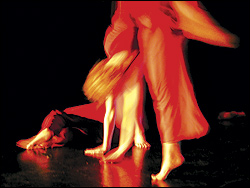Carla Barragan is in love with ideas, and her choreography is packed full of them—too full at times. In BEKoo (ends Saturday, Aug. 27, at Broadway Performance Hall; 206-325-6500), a new program for her BQdance ensemble, Barragan has created works about Mayan astrology and interconnectedness, terrorism and astronomy, anxiety and false comfort. Alongside this wealth of concepts, too, is a trove of movement themes and styles explored in detail.
Kuxan Suum, named for a Mayan concept about our connection to the universe, offers the most lavish portions, both in length and complexity. Barragan seems to combine some of the self-oriented aspects of contact improvisation with the more presentational quality of traditional modern dance. To a rhythmic guitar score by the Atomic Chamber Ensemble, Barragan’s performers surge through the space again and again, alternating between twitchy natural behaviors and theatricalized extensions of them. The movement could have been lifted from a typical scene at a bus stop, or a social dance, where a group of people might look questioningly at any newcomer. A nudge in line or a back turned away becomes a long sequence of shifting and shoving, either ostracizing the loner or artfully sliding everybody into yet another grouping.
Beth Graczyk, who has been dancing for almost everyone lately, does finely detailed work here, focusing our attention on her phrasing as she makes very specific choices about timing and energy. And Meg Fox’s lighting design, especially her use of intensely warm side light, helps clarify the overall structure of the piece, reinforcing the natural transitions and shaping the space. Yet, the piece still feels too long and dense.
The message is much more overt, however, in Esrellata, an exploration of personal responses to violence and crime. Here, the references to street scenes and human interaction—vignettes of flirting and flouncing, avoiding eye contact, even tripping over a derelict—are almost presented as is. Their literal nature makes them easy to grasp but sets us at a remove, blunting their kinesthetic power. The piece feels not so much a dance as it does people-watching through a cafe window on a Saturday night. Whatever happens is happening to them, so the big twist at the end of the work doesn’t affect us.
On the other hand, The Box, a film collaboration with Jeffrey Braverman, is whimsical and disturbing. Barragan drills a peephole into an rough wooden box, and sees herself inside. This is her only dancing in the program, and even with the inevitable distancing effect of film, she gives a kinetically fearless performance. She eats up the space, rolling in the gravel of an abandoned lot, scrambling along a chain-link fence or stretching luxuriously over what looks like a rusty barrel. Braverman’s editing, subtly speeding up and slowing down the image, reinforces the lurch in the pit of our stomachs. And when our focus is shifted “inside” the box, it’s like The Wizard of Oz—we move from black and white to color, from a dreary landscape to a world of possibilities (in this case, a stage and more traditional dance material).
The dun-colored head scarves and silvery backpacks that Sruti Desai and Diana Garcia-Snyder wear in Detour, the closing piece, appear at first to be automatic shorthand for dangerous places, a work based on a sense of anxiety. But when the performers pull a string, sand pours out of the bottom of their packs, undoing the initial feeling of menace. And when the packs glow with abstract symbols under a black light, they seem even less threatening—a lesson, perhaps, about reading too much into a program already bursting with concepts.








